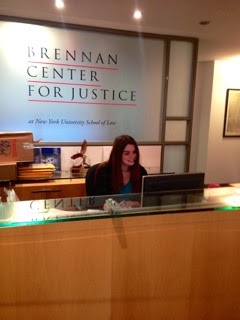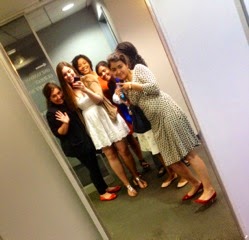 |
| Joshua (far right) with fellow researchers |
My name is
Joshua Seidman and I am currently a Verrazano student in the Class of 2016. I
am pursuing a BS degree in Biology with hopes of attending medical
school after I graduate. It is no surprise that to attend medical school
students must do well in school as well as complete internships and research
positions.
During the summer of 2013, right before I started my sophomore year, I was blessed with two major opportunities. The first opportunity was to shadow a surgeon for a week at Penn State Milton S. Hershey Medical Center. I met the surgeon through one of my father’s coworkers. This was pretty exciting, since it’s not everyday people get a chance to watch neurosurgery. I arrived not knowing what to expect, yet I was more anxious than ever before. I had been in the operating room many times before, but I never had a chance to see surgery like this.
When it was time for the first surgery, we walked into the operating room and the surgeon started to tell me what was going to happen during the procedure. He explained to me that when people have a disease such as Parkinson’s Disease or Tourette’s Syndrome, they have uncontrolled muscle spasms that prevent them from doing everyday tasks. He continued to explain that over time the muscle spasms progress and get worse, so medication that worked originally will stop working and leave the patient with few options for treatment. However, this procedure that he was about to do would really help the patient. The procedure was to implant a Deep Brain Stimulator into the patient’s brain in order to decrease the frequency and amplitude of these muscle spasms.
During the summer of 2013, right before I started my sophomore year, I was blessed with two major opportunities. The first opportunity was to shadow a surgeon for a week at Penn State Milton S. Hershey Medical Center. I met the surgeon through one of my father’s coworkers. This was pretty exciting, since it’s not everyday people get a chance to watch neurosurgery. I arrived not knowing what to expect, yet I was more anxious than ever before. I had been in the operating room many times before, but I never had a chance to see surgery like this.
When it was time for the first surgery, we walked into the operating room and the surgeon started to tell me what was going to happen during the procedure. He explained to me that when people have a disease such as Parkinson’s Disease or Tourette’s Syndrome, they have uncontrolled muscle spasms that prevent them from doing everyday tasks. He continued to explain that over time the muscle spasms progress and get worse, so medication that worked originally will stop working and leave the patient with few options for treatment. However, this procedure that he was about to do would really help the patient. The procedure was to implant a Deep Brain Stimulator into the patient’s brain in order to decrease the frequency and amplitude of these muscle spasms.
So what is a
Deep Brain Stimulator? It’s a device
that disrupts the electrical signals being sent to the brain that are causing
these spasms and prevents them from occurring involuntarily. But how do they
implant the stimulator? First they scan the patient’s head and get measurements
for a mold that can be put onto their head. This mold will then act as a map
and map out exactly where the stimulator should be placed. Once the mold is in
place it shows the doctors exactly where to make the holes in the skull in
order so that they can implant the stimulator.
Once the two holes are drilled, they then attach the stimulator to the mold
around the patient’s head and have it slowly implanted. A machine slowly
inserts the stimulator while a computer displays the brain waves and amplifies
their sounds. Based on comparison to normal brain waves, doctors can then tell
when they have reached the correct location for the stimulator. Once it is in
place, they remove the mold and they put caps in the holes of the skull in
order to close it. Lastly, they create a tunnel under the patient’s skin from
the top of their head, down their neck, and to their chest. They then feed the
stimulator wires through the tunnel. Once the wires have reached the chest they
make a small incision and hook the wires to a small battery that will stay in
the patient’s chest. Once the patient is sutured up, they turn on the
stimulator and the patient will start to feel relief immediately. Seeing this procedure was truly fascinating.
During that
week, I also viewed a surgery for chronic lower back pain and a brain tumor
assessment, but my favorite experience was watching the surgeon remove an
abscess in a patient’s brain. An
abscess is a collection of pus due to the inflammatory response to an infection. In order to remove it the doctor had to drill
through the skull and remove the skull cap. Than they slowly had to maneuver
around the cranial nerves and major blood vessels in order to get a sample of
the pus to determine what kind of bacterial infection they were dealing with.
Once they removed a majority of the pus they were able to get a sample and
determine that they can get rid of the bacterial infection with antibiotics. It was incredible!
The second
opportunity I had was to participate in research for six weeks at NYU. The lab
primarily researched pancreatic cancer and liver regeneration. I was paired up with a scientist who was researching
liver regeneration, so I didn’t really deal with the pancreatic research until
the end of my internship. The purpose of
our research was to investigate how the liver regenerates itself and potentially
find a way to increase the rate in order to save patients who have severe
hepatitis C and/or liver disease.
When I
arrived they explained to me that their ongoing research showed that there was
a ligand, a substance that forms a complex with a biomolecule to serve a
biological purpose, that would potentially increase the rate that the liver can
regenerate itself. The specific ligand we were dealing with was called Zymosan.
So how did we
test to see if this was a step in right direction? In order to test it, we did
what was called a hepatectomy. What this means is that we would surgically
remove three of the five lobes of mice
livers. Then before we sutured up the mice, we injected three of the six mice
with the ligand. The next step was to wait about 36 hours, and we then removed
the rest of their liver and sent it to a company that made us slides. The information we collected from the slides allowed
us to compare the number of cells between the livers of the three mice that
didn’t receive the ligand and the three that did.
Towards the
end of my research experience, I did work a few days with another scientist who
was working on creating a model of pancreatic cancer in mice that resembled
pancreatic cancer in humans. This has never been done before, because when
humans get pancreatic cancer it causes connective tissue deposits to form which
creates a fibrous like tumor. However, in mice they don’t get this fibrous
tumor. Every day we injected a number of mice with a certain type of injection
that actually created this fibrous tumor. This is the first time anyone has
created a perfect model of pancreatic cancer in mice.
There is definitely a lot more to
be said about my summer experiences, but I had to pick and choose what I felt was necessary to
mention. If anyone has any questions feel free to contact me. I hope this post
interested you and I hope it inspired you to go out and make a difference
through research or any other outlet that allows you to help change the world
one step at a time.





